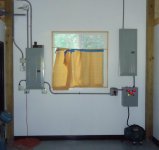First of all, this is my first post on the forum and am looking forward to being an active member.
So here is my dilemma.
I have a 12 x 36 lathe with a 3 phase 1.5 HP 10AMP motor getting ready to ship to me next week. After shopping around for a decent RPC, I narrowed my selection to the American Rotary AD-10 phase converter which is 10 HP and will do a startup of up to 28 AMP draw. The cost of the RPC is 950.00 lets just round up to 1k.
Having said that, I can step up to the 13 x 40 version of the 12 x 36 late but with hardened gears in the head and a single phase motor for an additional 1500.00. However, I wouldn't need the RPC.
What makes the decision difficult is that I don't really have a need for the 40" lathe. Don't think I will turn anything that large. But it will only set me back 500.00 for the upgrade.
Would you keep the 12 x 36 or do the 13 x 40 for an additional 500.00?
JT
So here is my dilemma.
I have a 12 x 36 lathe with a 3 phase 1.5 HP 10AMP motor getting ready to ship to me next week. After shopping around for a decent RPC, I narrowed my selection to the American Rotary AD-10 phase converter which is 10 HP and will do a startup of up to 28 AMP draw. The cost of the RPC is 950.00 lets just round up to 1k.
Having said that, I can step up to the 13 x 40 version of the 12 x 36 late but with hardened gears in the head and a single phase motor for an additional 1500.00. However, I wouldn't need the RPC.
What makes the decision difficult is that I don't really have a need for the 40" lathe. Don't think I will turn anything that large. But it will only set me back 500.00 for the upgrade.
Would you keep the 12 x 36 or do the 13 x 40 for an additional 500.00?
JT


